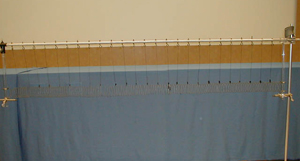Demos: 1S-13 Slinky on Stand

A long spring, called a Slinky, is supported horizontally by equally spaced strings. By pulling back on the end of the spring, a longitudinal pulse can be transmitted along the spring. With proper timing, standing waves can be established.
Directions: A single pull and release sends a pulse down the spring. Properly timed sequential pulls can establish a traveling and/or standing wave.
Suggestions for Presentation: First establish the conditions under which a compressional wave pulse is generated. Slowly pull back the spring and show how this creates a stretching, that when released will quickly return to equilibrium. But inertia cause the links to pass beyond the equilibrium point and create a compression. Thus, both a restoring force and inertia play key roles in the transmission of the wave.
Although difficult to see from the side, you shake the Slinky back and forth perpendicular to the spring to produce a transverse pulse/wave.
Applications: The slinky is a mechanical model simulating compressional waves in a variety of media. In the case of gases, the molecules undergo compression and rarefaction.
Last Updated: Nov 30, 2023 11:25 AM